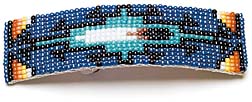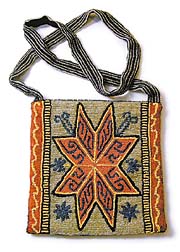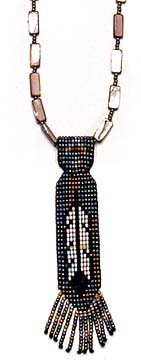Advertisement - Click to support our sponsors.


From bangles to bags,
fashion takes a spiritual turn with
accessories inspired by Native
American art formsJewelry tips
By Nadine Kam
Features Editor
Star-BulletinWE'VE crossed over from the 1900s to 2000, but that doesn't mean we're ready to leave the past. Running concurrently with machine-inspired metallic makeup, and futuristic lucite and silver accessories is the trend toward the natural: loom-beaded barrettes, suede lariats and leather bracelets accented with tufts of feathers, much of it inspired by Native American artistry.
Beaded chokers, headbands and feather-and-bead necklaces are plentiful at the youth-oriented Claire's accessory stores at Pearlridge and Windward Mall. These average about $5.
Right:
At Arden B. in Ala Moana Center, a faux turquoise bracelet goes for $12.50, while a feather-and-bead lariat goes for $24. Beaded bracelets are $10. Pair these with suede camisoles ($76), form-fitting reverse-seamed suede dresses in black or red ($148), pants trimmed in feathers, or any of a number of sueded jackets in sand, clay and adobe colors.
The hand-loomed, beaded kokopeli
(flute player) necklace, $36 at
Native Winds Gift Gallery, is by
Onondaga Indian White Crow.
Photo by George F. Lee, Star-Bulletin"People are looking for something different," said Arden B. assistant manager Wendy Carter. "There's been a lot of interest in ethnic fabrics and accessories, but people are tired of the Asia and India looks that have been so big."

While mimicking the red coral, bone and sky-blue turquoise colors often used in Native American jewelry, the inexpensive accessories available at youth-oriented boutiques are clearly glass or plastic.For those with a taste for the real thing, Native Winds Gift Gallery in Kaimuki (above Bead It!) carries sterling and turquoise jewelry, beaded leather and hand-loomed beadwork by several Native American artists.
Owner Wendy Schofield-Ching said, "I think people look to Native American culture because they've lost their own spirituality."
Among the Navajo, or Diné people, turquoise, coral, jet and mother of pearl are sacred minerals, perceived as gifts from Mother Earth. Turquoise is worn as a form of protection.
"You'll see Diné grandmothers herding sheep and they have on all this fabulous turquoise. I think that's so great! A piece of jewelry is not just an ornament. A Native American home will have beaded salt and pepper shakers. When they make things, there's no separation between utility, religion and function. There's a convergence of art, spirit and craft.

"It's all about living in balance and harmony with things around you."When manufacturers borrow from such a culture, there can be problems if they try to pass off items made in Asia or South America as being authentic.
Said Davey Malie, whose family of potters hails from the Acoma pueblo in New Mexico, "It devalues pieces if someone in China can sell an imitation for 1/10th the price. I just went to a powwow in California where someone was selling 'handmade' Indian dolls. I picked it up. It was made in Korea."
"Turquoise jewelry was really popular in the '70s," said Bill Tiger, owner of Tiger Hawaii, a shop specializing in drums, beaded jackets and animal skins. "It increased the income for Native American people who made jewelry, but it also created a market for forgeries."
On the plus side, Schofield-Ching said, such trends present an opportunity to learn more about a particular culture. "It's nice to see the authentic jewelry also getting the recognition," she said. "It can be such a rich experience."

Merchandise sales allow Schofield-Ching to support her passion, which is the educational aspect of her business. She became involved in Native American legal issues while working as a lawyer. She makes it clear she is not Native American herself.She provides curriculum materials for school teachers, often going into schools to talk about issues affecting the Native American community.
In the United States, for instance, it is illegal for anyone to falsely suggest an item is Indian produced if it is not. Problems with fakes in New Mexico have recently led retailers to request that artisans tag their wares with photographs and bios to ensure authenticity.
The popularity of Zuni jewelry and animal fetishes in recent years have made Zuni craft particularly vulnerable to imitation.

This does not extend to the current crop of fashion merchandise, which is meant to be worn for fun and is not intended to fool anyone.Tiger, of Muskogee-Creek heritage, said as long as retailers are not trying to pass off imitation jewelry as the real thing, it doesn't bother him if people want to wear feathers and beads inspired by native designs. "It's a type of flattery I guess you'd call it."

"Fashion can be fun, ornamental, and that's not offensive to people," Schofield-Ching said. "Indians got real good sense of humor. It's when people start imitating something sacred, dressing in eagle feathers or full powwow regalia, yeah, then that's going to be offensive."Some people have a romantic idea of how cool it is to be Indian when Native American people have suffered a lot and continue to suffer. I don't think anyone should forget that native people have been victims of an American holocaust," she said. "That's why it's important not to steal their jewelry."

Fashionistas exploring the source of today's trends may be interested to know that before Western explorers introduced tribes to seed beads, porcupine quills embellished apparel, jewelry and pouches. Schofield-Ching points to a not-for-sale porcupine quill pouch made by Dorothy Brave Eagle of the Lakota tribe that combines four colors -- black, white, yellow, red -- sacred to many tribes.Different tribes will have different meanings for the symbols and colors, as there are 500 cultures with their own language, religion and way of dress. But, she said, "When I see that pouch, I don't just see horses running across the bag, I see the sacred circle of life."

Here's what to look for in buying opaque semi-precious stones and Native American jewelry: Jewelry and gemstone tips
Artificially treated coral, turquoise or jade usually has an extra-bright color that may fade over time. The stones may have areas of concentrated color in thin lines.
Opaque stones can be imitated by a variety of materials, including glass and plastic. To recognize glass, look for pit marks on the surface, and small bubbles beneath it. Plastic is lighter than the real thing and often has rounded edges.
Bill Tiger, owner of Tiger Hawaii, said the simplest method for testing turquoise is touching a hot pin to it. "If it's plastic, it'll melt. Turquoise is a rock so heat won't hurt it. If a store owner doesn't want you to do it, that's suspicious."
When buying Native American jewelry, look for the artist's hallmark, a symbol or signature of the artist. Buy from an established dealer who will provide a guarantee of authenticity.
To sell as a Native American, one must be enrolled in a tribe. "There are 560 tribes and members will have a card with a roll number on it," said Tiger. "If they don't know what you're talking about, they're not for real."
Genuine handmade Indian jewelry is more expensive than mechanically produced or imported products. If the price seems too good to be true, it probably is, according to the Indian Arts and Crafts Association web site: http://www.iaca.com.

Caring for your investment:
Clean opaque semi-precious stones with mild, soapy water. Do not use an ultrasonic cleaning machine, which may alter the color.
Store opaque stones in a dark place. Intense light can bleach the color over time.
Do not expose opaque stones to damage from such common chemicals as hairspray or perfume.
Classes
Native Winds Gift Gallery & Craft Supply will begin offering classes next month. Subjects include Lakota language, silversmithing, beading on buckskin and making beaded barrettes. Call 734-8018 for information. The shop is at 1152 Koko Head Ave. Suite 202.
Click for online
calendars and events.